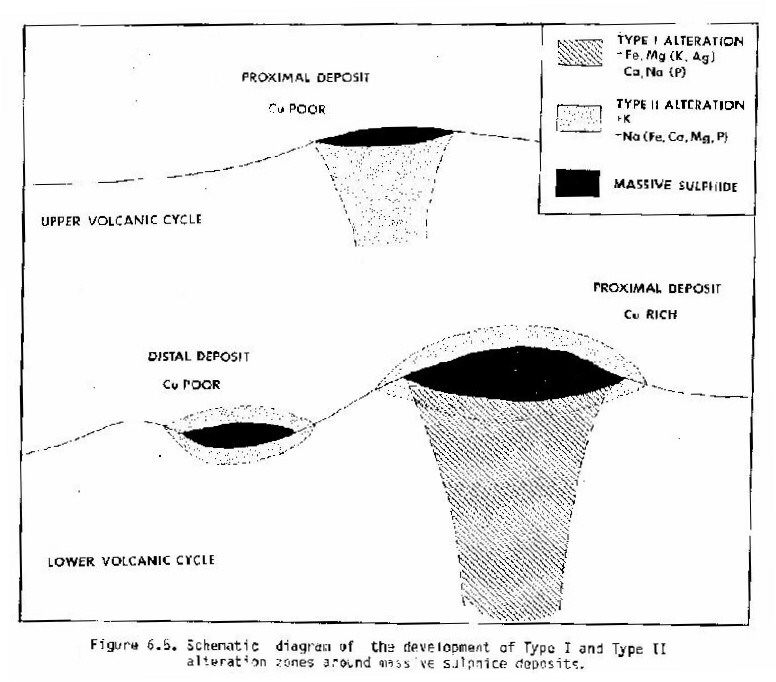The presence of primary wallrock dispersion haloes has been documented at or around volcanic-exhalative massive sulphide deposits of various ages. Certain specific single-element lithogeochemical signatures are common to the wallrocks of almost all these deposits, while others are documented less frequently, and in some cases the reported gain or loss of an element at one deposit is reversed at another. Recognition that more than one alteration type may be associated with these deposits requires a judgement as to the significance of such variations.
A previous investigation, based on analytical data from the wallrocks of eight massive sulphide deposits in Superior Province, demonstrated the presence of alteration haloes of various sizes. In general, these haloes were only discernible if the effects of igneous differentiation were compensated for. It was concluded that enrichment in Fe2O3, MgO, Cu, Zn, Mn and S, and depletion of CaO and Na2O, was common to the wallrocks of all the base-metal deposits studied, though developed to varying extents, and that the alteration haloes could be better defined by two parameters consisting of unweighted linear combinations of these major and trace elements, respectively.
This investigation has consisted of a re-examination of the same analytical data. It was prompted by the recognition that while an unweighted linear combination of elements may define wallrock alteration haloes more effectively than any of its individual component elements, it does not necessarily maximize the distinction between rocks spatially associated with massive sulphide, and rocks remote from any mineralization. Such weighted combinations, termed discriminant scores, may be derived by using discriminant analysis, a multivariate statistical method based on a priori knowledge of the classification (anomalous or background) of the samples used to generate the functions and scores.
Discriminant functions were derived for each of the eight deposits studied. Comparison of the scores calculated from such functions has enabled the identification of two distinct alteration types. The wallrocks of the Joutel, Poirier and East Waite deposits are characterized geochemically by enrichment in Fe2O3, MgO, K2O and Ag, and by depletion of CaO, Na2O and P2O5; this alteration type has been termed "Type I". At Joutel and Poirier, where the rocks have been subjected to greenschist-facies metamorphism, the mineralogical manifestations of this alteration type are chlorite and sericite; at East Waite, which was contact-metamorphosed by the Lake Dufault granodiorite prior to regional metamorphism, the alteration is represented by a partly retrograded cordierite-biotite-anthophyllite assemblage. Type I alteration is the result of the discharge of metalliferous hydrothermal fluids onto the sea floor. Thus, it can be expected to characterize deposits that have not been displaced from their source-vents.A different alteration style, termed "Type II", is evident in the samples collected from the South Bay, Mobrun, Sturgeon Lake and Agnico-Eagle deposits. This is characterized mineralogically by sericitization alone, and geochemically by enrichment in K2O, and depletion in Na2O, P2O5, Fe2O3 and MgO and is believed to result both from hydrothermal activity, under physicochemical conditions unfavourable to the formation of chlorite, and as a result of reaction between an oxidizing massive sulphide body and its wallrocks. Thus, it may be detected at any massive sulphide deposit, but assumes greater significance at deposits displaced from their source-vents, where a hydrothermal alteration zone is unlikely to be present. At the Mattabi deposit, which has a relatively unusual alteration mineral assemblage, both alteration types are well developed. Type I alteration manifests itself in the presence of chloritoid, chlorite and andalusite, while Type II is again represented by sericite. Despite the association of the two alteration types with diagnostic mineral assemblages, the discriminant score generally furnishes more information about the alteration state of the sample than does the modal mineralogy.
Generalized discriminant functions, suitable for delineating alteration zones of either type at any deposit, were derived from representative data sets consisting of altered samples from various deposits, showing affinity to one or other of the alteration types, and samples collcted remote from mineralization, showing affinity to neither alteration type. The alteration zones delineated by the scores for these functions are normally larger than the deposits themselves, the zones of visible alteration and the anomalous zones as delineated by the unweighted variable combinations. In sequences characterized by a predominance of pyroclastic rocks, such as Sturgeon Lake and Joutel-Poirier, the deposits are associated with regional anomalies several kilometres in extent. It is concluded that in such terranes, the discrminant scores constitute potentially useful regional exploration guides, but that all samples should be tested with functions representing both alteration types, because it is an oversimplification to direct exploration toward the detection of a single response. Because of the genetic association of Type II alteration with the masive sulphide itself, rather than its hydrothermal source-vent, the discriminant scores representing this alteration type may also be of application at the mine scale, in the search for extensions to existing orebdies. The use of discriminant analysis to compare the alteration styles from deposit to deposit may also have application to other deposit types.

